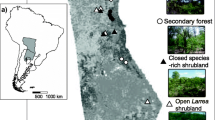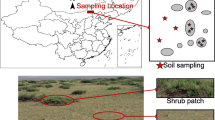Abstract
Aims
Soil organic carbon (SOC) storage is mainly governed by inputs from plant and microbial sources. How the relative contributions of these two sources in forest soils vary along broad-scale environmental gradients is poorly understood. The contributions of these two carbon sources in different soil layers are also elusive.
Methods
We used amino sugar and lignin phenol as biomarkers to indicate microbial- and plant-derived soil carbon. The concentrations of amino sugar and lignin phenol in topsoil (0–10 cm) and subsoil (30–60 cm) of major forest types along a latitude gradient in China were investigated.
Results
The concentration of soil amino sugar decreased along the latitude in topsoil, which is mainly controlled by the variations in mean annual temperature and soil nitrogen. The concentration of lignin phenols decreased along latitude in topsoil, mainly controlled by soil carbon/nitrogen ratio. The microbial-derived carbon was mainly composed of fungi-derived in topsoil, while bacteria-derived dominated in subsoil. Climate and soil properties are primary factors controlling the persistence of microbial residues and lignin phenols in topsoil, and soil clay is the crucial factor in the subsoil.
Conclusions
Both microbial residuals and lignin phenols in topsoil showed a decreasing trend with increasing latitude, but controlled by different sets of environmental factors. Subsoil microbial residues and lignin phenols showed no trend along the latitude and are mainly influenced by soil clay content.These findings provide new insights on how climate and vegetation affect soil carbon persistence, revealing significant distribution patterns of forest soil microbial residuals and lignin phenols along a latitude gradient.






Similar content being viewed by others
Data availability
The data that support the findings of this study are available from the corresponding author upon reasonable request.
References
Amelung W, Kimble JM, Samson-Liebig S, Follett RF (2001) Restoration of microbial residues in soils of the conservation reserve program. Soil Sci Soc Am J 65:1704–1709. https://doi.org/10.2136/sssaj2001.1704
Angst G, Mueller KE, Nierop KGJ, Simpson MJ (2021) Plant- or microbial-derived? A review on the molecular composition of stabilized soil organic matter. Soil Biol Biochem 156:108189. https://doi.org/10.1016/j.soilbio.2021.108189
Angst S, Cajthaml T, Angst G et al (2017) Retention of dead standing plant biomass (marcescence) increases subsequent litter decomposition in the soil organic layer. Plant Soil 418:571–579. https://doi.org/10.1007/s11104-017-3318-6
Bahram M, Hildebrand F, Forslund SK et al (2018) Structure and function of the global topsoil microbiome. Nature 560:233–237. https://doi.org/10.1038/s41586-018-0386-6
Baldocchi D, Falge E, Gu L et al (2001) FLUXNET: a new tool to study the temporal and spatial variability of ecosystem-scale carbon dioxide, water vapor, and energy flux densities. Bull Am Meteor Soc 82:2415–2434. https://doi.org/10.1175/1520-0477(2001)082%3c2415:FANTTS%3e2.3.CO;2
Balesdent J, Basile-Doelsch I, Chadoeuf J et al (2018) Atmosphere–soil carbon transfer as a function of soil depth. Nature 559:599–602. https://doi.org/10.1038/s41586-018-0328-3
Banfield CC, Pausch J, Kuzyakov Y, Dippold MA (2018) Microbial processing of plant residues in the subsoil-the role of biopores. Soil Biol Biochem 125:309–318. https://doi.org/10.1016/j.soilbio.2018.08.004
Bossio DA, Scow KM (1998) Impacts of carbon and flooding on soil microbial communities: phospholipid fatty acid profiles and substrate utilization patterns. Microb Ecol 35:265–278. https://doi.org/10.1007/s002489900082
Buckeridge KM, Creamer C, Whitaker J (2022) Deconstructing the microbial necromass continuum to inform soil carbon sequestration. Funct Ecol 36:1396–1410. https://doi.org/10.1111/1365-2435.14014
Chabbi A, Kögel-Knabner I, Rumpel C (2009) Stabilised carbon in subsoil horizons is located in spatially distinct parts of the soil profile. Soil Biol Biochem 41:256–261. https://doi.org/10.1016/j.soilbio.2008.10.033
Chen G, Ma S, Tian D et al (2020) Patterns and determinants of soil microbial residues from tropical to boreal forests. Soil Biol Biochem 151:108059. https://doi.org/10.1016/j.soilbio.2020.108059
Chen J, Luo Y, van Groenigen KJ et al (2018) A keystone microbial enzyme for nitrogen control of soil carbon storage. Sci Adv 4:eaaq1689. https://doi.org/10.1126/sciadv.aaq1689
Chen X, Hu Y, Xia Y et al (2021) Contrasting pathways of carbon sequestration in paddy and upland soils. Glob Change Biol 27:2478–2490. https://doi.org/10.1111/gcb.15595
Clemente JS, Simpson MJ (2013) Physical protection of lignin by organic matter and clay minerals from chemical oxidation. Org Geochem 58:1–12. https://doi.org/10.1016/j.orggeochem.2013.02.007
Cotrufo MF, Wallenstein MD, Boot CM et al (2013) The Microbial Efficiency-Matrix Stabilization (MEMS) framework integrates plant litter decomposition with soil organic matter stabilization: do labile plant inputs form stable soil organic matter? Glob Change Biol 19:988–995. https://doi.org/10.1111/gcb.12113
Don A, Schulze E-D (2008) Controls on fluxes and export of dissolved organic carbon in grasslands with contrasting soil types. Biogeochemistry 91:117–131. https://doi.org/10.1007/s10533-008-9263-y
Engelking B, Flessa H, Joergensen RG (2007) Shifts in amino sugar and ergosterol contents after addition of sucrose and cellulose to soil. Soil Biol Biochem 39:2111–2118. https://doi.org/10.1016/j.soilbio.2007.03.020
Fan Y, Yang L, Zhong X et al (2020) N addition increased microbial residual carbon by altering soil P availability and microbial composition in a subtropical castanopsis forest. Geoderma 375:114470. https://doi.org/10.1016/j.geoderma.2020.114470
Fanin N, Bertrand I (2016) Aboveground litter quality is a better predictor than belowground microbial communities when estimating carbon mineralization along a land-use gradient. Soil Biol Biochem 94:48–60. https://doi.org/10.1016/j.soilbio.2015.11.007
Feng X, Simpson MJ (2007) The distribution and degradation of biomarkers in Alberta grassland soil profiles. Org Geochem 38:1558–1570. https://doi.org/10.1016/j.orggeochem.2007.05.001
Glaser B, Turrión M-B, Alef K (2004) Amino sugars and muramic acid—biomarkers for soil microbial community structure analysis. Soil Biol Biochem 36:399–407. https://doi.org/10.1016/j.soilbio.2003.10.013
Griepentrog M, Bode S, Boeckx P et al (2014) Nitrogen deposition promotes the production of new fungal residues but retards the decomposition of old residues in forest soil fractions. Glob Change Biol 20:327–340. https://doi.org/10.1111/gcb.12374
Hagerty SB, van Groenigen KJ, Allison SD et al (2014) Accelerated microbial turnover but constant growth efficiency with warming in soil. Nat Clim Change 4:903–906. https://doi.org/10.1038/nclimate2361
Hautala K, Peuravuori J, Pihlaja K (1997) Estimation of origin of lignin in humic DOM by CuO-oxidation. Chemosphere 35:809–817. https://doi.org/10.1016/S0045-6535(97)00201-4
He M, Fang K, Chen L et al (2022) Depth-dependent drivers of soil microbial necromass carbon across Tibetan alpine grasslands. Glob Change Biol 28:936–949. https://doi.org/10.1111/gcb.15969
Hedges JI, Ertel JR (1982) Characterization of lignin by gas capillary chromatography of cupric oxide oxidation products. Anal Chem 54:174–178. https://doi.org/10.1021/ac00239a007
Heim A, Schmidt MWI (2007) Lignin turnover in arable soil and grassland analysed with two different labelling approaches. Eur J Soil Sci 58:599–608. https://doi.org/10.1111/j.1365-2389.2006.00848.x
Hernes PJ, Kaiser K, Dyda RY, Cerli C (2013) Molecular trickery in soil organic matter: hidden lignin. Environ Sci Technol 47:9077–9085. https://doi.org/10.1021/es401019n
Hu J, Huang C, Zhou S et al (2022) Nitrogen addition increases microbial necromass in croplands and bacterial necromass in forests: a global meta-analysis. Soil Biol Biochem 165:108500. https://doi.org/10.1016/j.soilbio.2021.108500
IPCC (2021) Summary for policymakers. In: Climate Change 2021: The Physical Science Basis. Contribution of Working Group I to the Sixth Assessment Report of the Intergovernmental Panel on Climate Change, pp 3–32
Jex CN, Pate GH, Blyth AJ et al (2014) Lignin biogeochemistry: from modern processes to quaternary archives. Quatern Sci Rev 87:46–59. https://doi.org/10.1016/j.quascirev.2013.12.028
Jia S, Liu X, Lin W et al (2022) Tree roots exert greater influence on soil microbial necromass carbon than above-ground litter in subtropical natural and plantation forests. Soil Biol Biochem 173:108811. https://doi.org/10.1016/j.soilbio.2022.108811
Jia Y, Zhai G, Zhu S et al (2021) Plant and microbial pathways driving plant diversity effects on soil carbon accumulation in subtropical forest. Soil Biol Biochem 161:108375. https://doi.org/10.1016/j.soilbio.2021.108375
Joergensen RG (2018) Amino sugars as specific indices for fungal and bacterial residues in soil. Biol Fertil Soils 54:559–568. https://doi.org/10.1007/s00374-018-1288-3
Kaiser K, Guggenberger G (2000) The role of DOM sorption to mineral surfaces in the preservation of organic matter in soils. Org Geochem 31:711–725. https://doi.org/10.1016/S0146-6380(00)00046-2
Kuzyakov Y, Domanski G (2000) Carbon input by plants into the soil. Review. J Plant Nutr Soil Sci 163:421–431. https://doi.org/10.1002/1522-2624(200008)163:4<421::AID-JPLN421>3.0.CO;2-R
Lavallee JM, Soong JL, Cotrufo MF (2020) Conceptualizing soil organic matter into particulate and mineral-associated forms to address global change in the 21st century. Glob Change Biol 26:261–273. https://doi.org/10.1111/gcb.14859
Lehmann J, Kleber M (2015) The contentious nature of soil organic matter. Nature 528:60–68. https://doi.org/10.1038/nature16069
Liang C, Amelung W, Lehmann J, Kästner M (2019a) Quantitative assessment of microbial necromass contribution to soil organic matter. Glob Change Biol 25:3578–3590. https://doi.org/10.1111/gcb.14781
Liang Z, Olesen JE, Jensen JL, Elsgaard L (2019b) Nutrient availability affects carbon turnover and microbial physiology differently in topsoil and subsoil under a temperate grassland. Geoderma 336:22–30. https://doi.org/10.1016/j.geoderma.2018.08.021
Liang C, Schimel JP, Jastrow JD (2017) The importance of anabolism in microbial control over soil carbon storage. Nat Microbiol 2:1–6. https://doi.org/10.1038/nmicrobiol.2017.105
Ma S, Zhu B, Chen G et al (2021) Loss of soil microbial residue carbon by converting a tropical forest to tea plantation. Sci Total Environ. https://doi.org/10.1016/j.scitotenv.2021.151742
Ma T, Dai G, Zhu S et al (2020) Vertical variations in plant- and microbial-derived carbon components in grassland soils. Plant Soil 446:441–455. https://doi.org/10.1007/s11104-019-04371-9
Ma T, Zhu S, Wang Z et al (2018) Divergent accumulation of microbial necromass and plant lignin components in grassland soils. Nat Commun 9:3480. https://doi.org/10.1038/s41467-018-05891-1
Mou Z, Kuang L, He L et al (2021) Climatic and edaphic controls over the elevational pattern of microbial necromass in subtropical forests. Catena 207:105707. https://doi.org/10.1016/j.catena.2021.105707
Murugan R, Djukic I, Keiblinger K et al (2019) Spatial distribution of microbial biomass and residues across soil aggregate fractions at different elevations in the Central Austrian Alps. Geoderma 339:1–8. https://doi.org/10.1016/j.geoderma.2018.12.018
Ni X, Liao S, Tan S et al (2020a) The vertical distribution and control of microbial necromass carbon in forest soils. Glob Ecol Biogeogr. https://doi.org/10.1111/geb.13159
Ni X, Liao S, Tan S et al (2020b) A quantitative assessment of amino sugars in soil profiles. Soil Biol Biochem 143:107762. https://doi.org/10.1016/j.soilbio.2020.107762
Pan Y, Birdsey RA, Fang J et al (2011) A large and persistent carbon sink in the world’s forests. Science 333:988–993. https://doi.org/10.1126/science.1201609
Rahman MM, Tsukamoto J, Rahman MM et al (2013) Lignin and its effects on litter decomposition in forest ecosystems. Chem Ecol 29:540–553. https://doi.org/10.1080/02757540.2013.790380
Rodionow A, Flessa H, Kazansky O, Guggenberger G (2006) Organic matter composition and potential trace gas production of permafrost soils in the forest tundra in northern Siberia. Geoderma 135:49–62. https://doi.org/10.1016/j.geoderma.2005.10.008
Rumpel C, Kögel-Knabner I (2011) Deep soil organic matter—a key but poorly understood component of terrestrial C cycle. Plant Soil 338:143–158. https://doi.org/10.1007/s11104-010-0391-5
Stevenson FJ (1983) Isolation and identification of amino sugars in soil. Soil Sci Soc Am J 47:61–65. https://doi.org/10.2136/sssaj1983.03615995004700010012x
Talbot JM, Treseder KK (2012) Interactions among lignin, cellulose, and nitrogen drive litter chemistry-decay relationships. Ecology 93:345–354. https://doi.org/10.1890/11-0843.1
Tamura M, Suseela V, Simpson M et al (2017) Plant litter chemistry alters the content and composition of organic carbon associated with soil mineral and aggregate fractions in invaded ecosystems. Glob Change Biol 23:4002–4018. https://doi.org/10.1111/gcb.13751
Tedersoo L, Bahram M, Põlme S et al (2014) Global diversity and geography of soil fungi. Science 346:1256688. https://doi.org/10.1126/science.1256688
Thevenot M, Dignac M-F, Rumpel C (2010) Fate of lignins in soils: a review. Soil Biol Biochem 42:1200–1211. https://doi.org/10.1016/j.soilbio.2010.03.017
Wang Q-C, Wang W, Zheng Y et al (2022) Converting rice paddy to upland fields decreased plant lignin but increased the contribution of microbial residue to SOC. Geoderma 425:116079. https://doi.org/10.1016/j.geoderma.2022.116079
Wang X, Tian Q, Li Q et al (2018) Lignin characteristics in soil profiles in different plant communities in a subtropical mixed forest. J Plant Ecol 11:560–568. https://doi.org/10.1093/jpe/rtx028
Wang X, Wang C, Cotrufo MF et al (2020) Elevated temperature increases the accumulation of microbial necromass nitrogen in soil via increasing microbial turnover. Glob Change Biol 26:5277–5289. https://doi.org/10.1111/gcb.15206
Xia Y, Chen X, Hu Y et al (2019) Contrasting contribution of fungal and bacterial residues to organic carbon accumulation in paddy soils across eastern China. Biol Fertil Soils 55:767–776. https://doi.org/10.1007/s00374-019-01390-7
Yang L, Lyu M, Li X et al (2020) Decline in the contribution of microbial residues to soil organic carbon along a subtropical elevation gradient. Sci Total Environ 749:141583. https://doi.org/10.1016/j.scitotenv.2020.141583
Yang Y, Dou Y, Wang B et al (2022) Increasing contribution of microbial residues to soil organic carbon in grassland restoration chronosequence. Soil Biol Biochem 170:108688. https://doi.org/10.1016/j.soilbio.2022.108688
Zhang Q, Li X, Liu J et al (2023) The contribution of microbial necromass carbon to soil organic carbon in soil aggregates. Appl Soil Ecol 190:104985. https://doi.org/10.1016/j.apsoil.2023.104985
Zhang X, Amelung W (1996) Gas chromatographic determination of muramic acid, glucosamine, mannosamine, and galactosamine in soils. Soil Biol Biochem 28:1201–1206. https://doi.org/10.1016/0038-0717(96)00117-4
Zhao G, Zhang Y, Cong N et al (2022) Climate warming weakens the negative effect of nitrogen addition on the microbial contribution to soil carbon pool in an alpine meadow. Catena 217:106513. https://doi.org/10.1016/j.catena.2022.106513
Zhou W, Ma T, Yin X et al (2023) Dramatic carbon loss in a permafrost thaw slump in the Tibetan plateau is dominated by the loss of microbial necromass carbon. Environ Sci Technol. https://doi.org/10.1021/acs.est.2c07274
Zhu S, Dai G, Ma T et al (2019) Distribution of lignin phenols in comparison with plant-derived lipids in the alpine versus temperate grassland soils. Plant Soil 439:325–338. https://doi.org/10.1007/s11104-019-04035-8
Zhu X, Jackson RD, DeLucia EH et al (2020) The soil microbial carbon pump: from conceptual insights to empirical assessments. Glob Change Biol 26:6032–6039. https://doi.org/10.1111/gcb.15319
Funding
This study was supported by the National Natural Science Foundation of China (Grant numbers 32171599, 31870465).
Author information
Authors and Affiliations
Contributions
F. Liu, Q. Lin, and Q. Tian conceived and designed the study. C. Liao collected the soil sample and data. Q. Lin performed the experiment and analyzed the data. F. Liu, Q. Lin, Q. Tian, X. Yuan, and M. Lu contributed substantially to manuscript revisions. All authors reviewed and edited the manuscript.
Corresponding author
Ethics declarations
Competing interests
The authors declare no competing interests.
Additional information
Responsible editor: Jizheng He
Publisher's Note
Springer Nature remains neutral with regard to jurisdictional claims in published maps and institutional affiliations.
Supplementary Information
Below is the link to the electronic supplementary material.
Rights and permissions
Springer Nature or its licensor (e.g. a society or other partner) holds exclusive rights to this article under a publishing agreement with the author(s) or other rightsholder(s); author self-archiving of the accepted manuscript version of this article is solely governed by the terms of such publishing agreement and applicable law.
About this article
Cite this article
Lin, Q., Tian, Q., Liao, C. et al. Persistence of soil microbial residuals and lignin phenols in forest ecosystems along the latitude gradient. J Soils Sediments (2024). https://doi.org/10.1007/s11368-024-03794-x
Received:
Accepted:
Published:
DOI: https://doi.org/10.1007/s11368-024-03794-x




